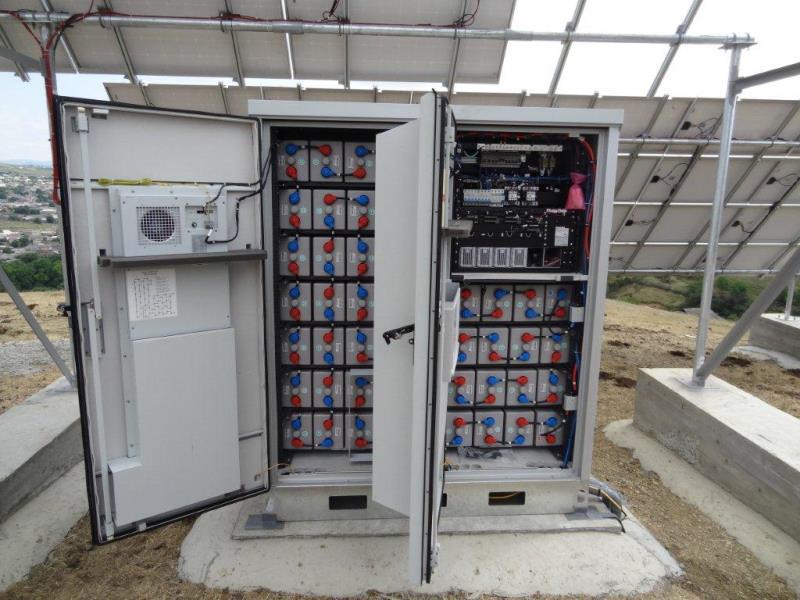Report: solar powered base station

This year, MegaFon transferred one of its base stations (BS) in the North Caucasus (North Caucasus Federal District) to an alternative power supply system - electricity for the station is generated from solar energy.
Little about the base station
1. Built in 2006 on Mount Tash-Bash (643 m above sea level).
2. Coverage area: villages of Lower and Upper Kazanische, the total population of about 15,000 people.
3. Power - the usual power line, plus a gas generator in case of emergency situations.
Why did you decide to transfer to alternative energy sources? The reason is simple: constant problems with the electricity supplier - up to 20 accidents per month. Of course, the gas generator insured, but in such conditions the batteries failed very quickly, they had to be changed every six to eight months.
Not surprisingly, MegaFon solved this problem once and for all by installing an alternative power source. The experience has already been - in Tajikistan, some BS of the operator "TT-Mobile" (owned by "MegaFon") operate on solar batteries.
')

Design
The most difficult moment in the design was the calculation of the area, the angle of inclination of the solar panels depending on the geographical coordinates of the object, the power of solar radiation in terms of year-round use, the maximum and average required power of the load.
The required power of the solar panels was calculated based on many factors: time of year, time of day, weather conditions and geographic location. These factors were assessed for the minimum - for the worst month (for the area - this is January), average values - for most of the year (February-November), and for the summer maximum (for the area) it is July.
System selection
The installed system had to meet a variety of conditions that ensure uninterrupted and trouble-free operation of the base station equipment. The most important of them are:
- stable supply voltage 40-60 V DC;
- required load current 80–100 A;
- the necessary time of operation of the equipment in the dark from batteries;
- economically reasonable payback period of the equipment.
Installation
The object is located in a fairly convenient area for installation, access roads are of federal and republican significance.
Delivery and installation of equipment did not cause any special difficulties.
What the system consists of
The system consists of panels with photovoltaic cells, a solar battery controller, a hybrid power supply unit, and rechargeable batteries.
- Panels There are currently 42 solar panels operating in the facility, each with 72 photocells. The total area of the panels is 53 sq. M. m, they are able to generate up to 5 kW. The panels can operate at temperatures from –40 to +85 degrees Celsius.
The surface of the panels is protected by hardened glass, the strength of which is enough to prevent all possible damage, except, of course, acts of targeted vandalism.
- Batteries Battery capacity lasts about 12 hours of battery life.
Naturally, the connection to the power grid is preserved, but only as a backup power supply channel - with a possible drop in the battery capacity below 70% in the absence of power supply from solar panels (dark, cloudy).

Works? Works!
The project took two months to complete - in the summer of 2014, the BS was connected to a new power complex. After conversion, the complex produces standard AC 380V, 50 Hz.
MegaFon specialists monitor the station’s power supply system remotely. The duty engineer of operation, if necessary, can make changes in the system configuration through the remote control interface, monitor the condition of the batteries, and monitor other technical parameters of the system. Since July 15, since the launch of the alternative power supply system, there have been no interruptions in the operation of the equipment.

Solar panels do not require special maintenance, that is, the cost of ownership is low. Initially, of course, we had to spend money on their purchase and installation - the cost of the project is comparable to the cost of building a high-voltage transmission line. It is no secret that the main disadvantage of this alternative energy source is the high price. But this project will pay off in two or three years.
What will happen next?
We hope for mass application of such technologies in the future. This requires a qualitative breakthrough in the cost of producing solar panels (and ultimately their final cost) and / or increasing the efficiency of converting solar energy into electrical energy.
It is hoped that this will happen in the near future. In August of this year, the laboratory of the University of Liverpool announced that it had developed a new, significantly less expensive method of producing certain type of solar cells. The cost of their release can be reduced by replacing the toxic substances used in the production, such that can be found in regular bath salts. More than 90% of solar cells are made of silicon, about 7% - of cadmium telluride. The latter are thinner and lighter, but their production uses toxic and expensive cadmium chloride.
Scientists from Liverpool have figured out how to replace it with non-toxic magnesium chloride. According to the head of this research project, Dr. John Major, this will help reduce the cost of solar energy to the level of fossil fuels.
Until this happened, there are few base stations for which the construction of such an energy complex would be justified. MegaFon plans to install solar panels on two more base stations in the near future.
Friends, if you have any questions - we will be happy to answer them in the comments.
PS: The base station has now become so special that they have decided to give it a name - the station is named after Anvar Hamidov, a famous Kumyk poet, translator and teacher, who was born in 1924 just in the village of Nizhny Kazanische.
Source: https://habr.com/ru/post/241365/
All Articles